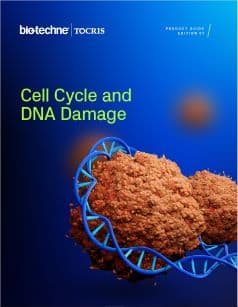Aurora Kinases
Aurora kinases are a family of three highly homologous serine/threonine kinases that play a critical role in regulating many of the processes that are pivotal to mitosis. Each of the isoforms, Aurora A, Aurora B and Aurora C, has a different function in the control of mitosis.
Aurora Kinase Inhibitors |
|
|---|---|
| Cat. No. | 产品名称/活性 |
| 7865 | AMG 900 |
| Potent pan-Aurora kinase inhibitor | |
| 3988 | Hesperadin hydrochloride |
| Potent Aurora kinase B inhibitor | |
| 3395 | Lestaurtinib |
| Potent Aurora kinase A and B inhibitor; also inhibits JAK2, FLT3 and TrkA | |
| 3301 | NU 6140 |
| Potent aurora kinase A and B inhibitor; also inhibits cdk2 | |
| 4066 | TC-A 2317 hydrochloride |
| Potent, selective Aurora kinase A inhibitor | |
| 2458 | ZM 447439 |
| Inhibits Aurora kinase B | |
Aurora Kinase Activators |
|
| Cat. No. | 产品名称/活性 |
| 3084 | Anacardic acid |
| Aurora kinase A activator; also inhibits histone acetyltransferase | |
Degraders |
|
| Cat. No. | 产品名称/活性 |
| 7837 | JB 300 |
| Aurora A Degrader (PROTAC®) | |
Aurora kinases are a family of three highly homologous serine/threonine kinases that play a critical role in regulating many of the processes that are pivotal to mitosis. Each isoform, Aurora A, Aurora B and Aurora C, has a different function in the control of this process.
Aurora A is involved in regulating many of the early mitotic events where its levels peak, particularly during the G2 phase. One target of Aurora A is cdc25b, a direct regulator of the cyclin B1-Cdk1 complex, which provides the basis for the role this enzyme plays in regulating entry into mitosis. Aurora A regulates centrosome maturation by moderating the recruitment of proteins, such as TPX-2, Ajuba, Bora and Lats, which are essential for accumulating microtubule spindle components, such as γ-tubulin. Aurora A is also associated with separation of centrosomes, through phosphorylation of the kinesin motor protein, Eg5. In addition, this enzyme regulates the microtubule network that forms mitotic spindles, through regulation of the EXTAH multiprotein complex.
Aurora B is the catalytic component of the chromosomal passenger complex (CPC) that is critical for the correct progression through and completion of mitosis. CPC is composed of three other proteins, survivin, INCENP and borealin, which are all substrates for Aurora B and function to regulate the activity of this enzyme. The CPC initially forms along chromosome arms, then concentrates at the centromere before finally localizing to the spindle midzone during cytokinesis. Functions of the CPC include condensation of chromosomes, formation of the bipolar spindle, attachment of the chromosomes to the mitotic spindle, regulation of the spindle checkpoint and completion of cytokinesis. An important target of Aurora B is histone H3, which is a critical regulator of chromosome condensation. H3 phosphorylation is a biomarker of Aurora B activity.
Aurora C is the least well studied member of this family and is expressed in most somatic tissues at levels much lower than Aurora A or B. However, expression is high in the testis, where this enzyme is thought to have a role in spermatozoa formation. During the cell cycle, the localization of Aurora C is dynamic and consistent with it being a CPC protein. In addition, Aurora C colocalizes with Aurora B during mitosis, suggesting that these isoforms may have an overlapping role with a degree of redundancy.
Since their discovery in the 1990s, Aurora kinases have been strongly linked to the progression of human cancers. Aurora A maps to human chromosome 20q13 and Aurora B to human chromosome 17q13.1, which are loci altered frequently in human cancers. Overexpression of Aurora A and B is seen in many cancers, but these enzymes are not oncoproteins, as concomitant oncogenic mutations are required to promote tumor progression. Aurora kinase inhibitors are an intense area of research for the development of cancer therapies.
External sources of pharmacological information for Aurora Kinases :
Literature for Aurora Kinases
Tocris offers the following scientific literature for Aurora Kinases to showcase our products. We invite you to request* your copy today!
*Please note that Tocris will only send literature to established scientific business / institute addresses.
Cell Cycle and DNA Damage Research Product Guide
This product guide provides a review of the cell cycle and DNA damage research area and lists over 150 products, including research tools for:
- Cell Cycle and Mitosis
- DNA Damage Repair
- Targeted Protein Degradation
- Ubiquitin Proteasome Pathway
- Chemotherapy Targets
Cell Cycle & DNA Damage Repair Poster
In normal cells, each stage of the cell cycle is tightly regulated, however in cancer cells many genes and proteins that are involved in the regulation of the cell cycle are mutated or over expressed. This poster summarizes the stages of the cell cycle and DNA repair. It also highlights strategies for enhancing replicative stress in cancer cells to force mitotic catastrophe and cell death.
Aurora Kinase Gene Data
| Gene | Species | Gene Symbol | Gene Accession No. | Protein Accession No. |
|---|---|---|---|---|
| Aurora Kinase A | Human | AURKA | NM_003600 | O14965 |
| Mouse | Aurka | NM_011497 | P97477 | |
| Rat | Aurka | NM_153296 | P59241 | |
| Aurora Kinase B | Human | AURKB | NM_004217 | Q96GD4 |
| Mouse | Aurkb | NM_011496 | O70126 | |
| Rat | Aurkb | NM_053749 | O55099 | |
| Aurora Kinase C | Human | AURKC | NM_003160 | Q9UQB9 |
| Mouse | Aurkc | NM_001080966 | O88445 | |
| Rat | Aurkc | NM_001106221 | - |

